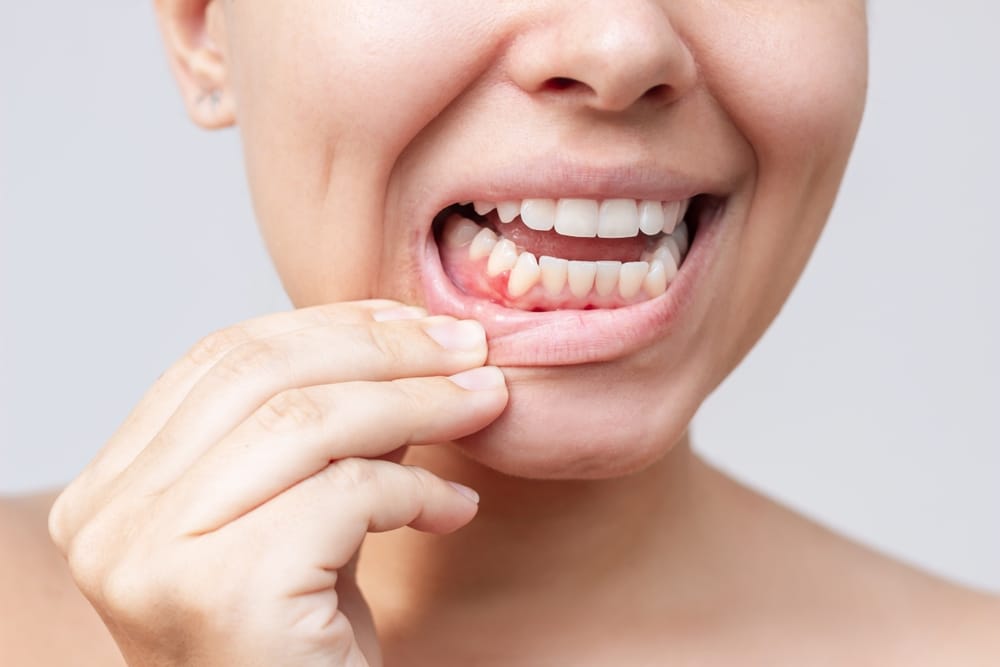Understanding Gum Disease
Keeping your gums healthy is crucial for a bright smile and good health. Knowing the basics of gum disease and spotting its first signs can help you take steps to prevent it. Let’s look at why gum health matters and how to spot early warning signs.
Ignoring your gum health can lead to serious problems like tooth loss and other health issues. Focusing on good oral hygiene and visiting the dentist regularly can significantly lower your chances of getting gum disease. This will help you maintain a healthy smile for many years.
What is Gum Disease?
Gum disease, or periodontal disease, results from bacteria in the mouth causing an infection in tooth-supporting tissues. It begins with plaque buildup and can progress to tartar, leading to gum irritation, inflammation, and bleeding. Untreated, it can cause bone and tooth loss. Understanding its causes, symptoms, and treatments is crucial for oral health.
The Importance of Early Detection
Detecting gum disease early is crucial for effective treatment and oral health. Watch for warning signs like bleeding, swelling, or bad breath. , or loose teeth. Early detection simplifies treatment, which may involve professional cleaning or scaling. Timely care protects teeth, gums, and overall health. Regular dental visits are essential for maintaining healthy teeth and should be part of your healthcare routine.
Early Signs of Gum Disease
Recognizing the early signs of gum disease is important. It helps you get treatment quickly and avoid more problems. Some signs may be small, but noticing any changes in your mouth can help you fix issues before they grow.
Finding and treating gum disease in its early stages is key for controlling the infection and keeping your mouth healthy. If you see any of the following signs, you should visit your dentist. This way, you can discuss your worries and get the necessary care.
Red and Swollen Gums
One of the first signs of gum disease is red, swollen gums. Healthy gums are pink and strong. When affected by gum disease, tissue can become inflamed and change color—indicating a problem. Consult your dentist promptly if your gums remain red, swollen, or tender. Early detection and treatment can prevent further damage and maintain oral health.
Bleeding While Brushing or Flossing
Bleeding gums while brushing or flossing can signal gum disease caused by plaque and tartar buildup. Consistent oral hygiene is crucial. Tips include brushing twice daily with fluoride toothpaste, flossing, and using ADA-approved mouthwash for fresh breath and reducing bacteria.
Persistent Bad Breath
Persistent bad breath (halitosis) is embarrassing and worrying, often caused by gum disease. Bacteria from gum disease produce smelly volatile sulfur compounds (VSCs). To reduce these bacteria, improve oral hygiene. See a dentist if you have bad breath to check for gum disease and other oral health issues. Addressing these causes and maintaining good oral hygiene can eliminate bad breath and promote a healthier mouth.
Risk Factors Contributing to Gum Disease
Poor oral hygiene mainly causes gum disease, but other things can raise your risk. Knowing these risk factors can help you take steps to protect your oral health.
Some risk factors are out of our control. These include genetics and certain health issues. Still, taking charge of the factors we can control and using preventive measures can significantly lower our chances of getting gum disease. It is important to know these risk factors for better protection of your oral health.
Poor Oral Hygiene Practices
Smoking and using tobacco can greatly increase your chances of getting gum disease and also contribute to an increased risk of other health problems. The harmful chemicals in tobacco products can weaken your immune system. This makes it hard for your body to fight infections, especially in your gums.
Dental plaque is a sticky layer full of bacteria. These bacteria eat leftover food in our mouths. They produce acids that harm tooth enamel and upset the gums, leading to more inflammation and possible infections.
If we don’t clean our teeth properly, plaque can turn into tartar over time. Tartar is much harder to eliminate with just regular brushing and flossing. It worsens gum inflammation and allows bacteria to grow, which can cause gum disease.
Smoking and Tobacco Use
Smoking and using tobacco can greatly increase your chances of getting gum disease. The harmful chemicals in tobacco products can weaken your immune system. This makes it hard for your body to fight off infections, especially in your gums.
Also, smoking reduces blood flow to your gums. This limits the oxygen and nutrients necessary for keeping your gums healthy. With less blood supply, your gums struggle to heal and fight off infections.
Oral hygiene habits and lifestyle impact gum health, while genetics can influence gum disease risk. Genetic predisposition may lead to heightened inflammatory responses or increased harmful bacteria in the mouth. According to the American Academy of Periodontology, if gum disease runs in your family, prioritize oral health and consult your dentist for more frequent checkups and cleanings.
Genetic Susceptibility
Oral hygiene habits and lifestyle impact gum health, while genetics can influence gum disease risk. Genetic predisposition may lead to heightened inflammatory responses or increased presence of harmful bacteria in the mouth. If gum disease runs in your family, prioritize oral health and consult your dentist for more frequent checkups and cleanings.
Preventative Measures for Gum Health
Preventing gum disease is much better than dealing with it once it becomes serious. Luckily, some easy and effective steps can lower your risk and keep your gums healthy. If you add these practices to your daily life, you can have a nice smile for many years.
Remember, prevention takes ongoing effort, so it’s important to stick to these habits for good long-term oral health. Taking care of your gums in advance is always the smart way to keep your smile bright and healthy.
Proper Brushing and Flossing Techniques
Proper brushing and flossing are essential for good oral hygiene as they prevent gum disease. Brush your teeth twice daily with fluoride toothpaste for two minutes to remove food and plaque. Floss once daily to clean between teeth and below the gum line, using gentle C-shaped motions. Seek guidance from your dentist or hygienist if needed.
Incorporating these habits into your routine helps remove plaque, reduce tartar buildup, and maintain oral health. Good oral care prevents gum disease and enhances overall oral health.
Regular Dental Checkups
Regular dental checkups are crucial for managing gum disease. Dentists inspect for signs of issues like swelling or infection. Professional cleanings help remove hard-to-reach plaque and tartar, ensuring early problem detection and timely treatment.
Choosing the Right Oral Care Products
Choose oral care products carefully for gum health and hygiene. Opt for a soft-bristled toothbrush and fluoride toothpaste with an ADA Seal of Acceptance. Consider using antibacterial mouthwash to reduce bacteria and freshen your breath. Consult your dentist for personalized recommendations based on specific needs.
Schedule an Appointment
If you’re suffering from symptoms of gum disease, don’t wait. Schedule an appointment today.

